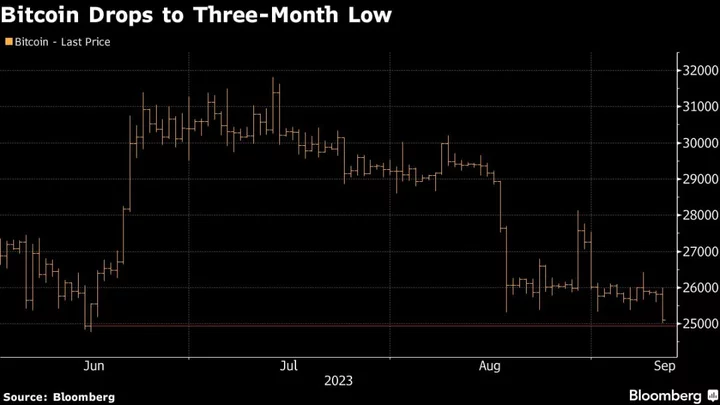This summer in the UK is expected to be hotter than normal, though temperatures aren’t forecast to break last year’s record-setting level yet.
Early signs suggest higher-than-average heat is likely to occur in the UK and across southern Europe for the rest of the month and the beginning of July, according to climate scientists from the Met Office and the bloc’s Earth observation agency Copernicus. But it’s hard to predict whether Britain will see another day with mercury breaching the 40C (104F) mark like the one that occurred last July.
“You can never rule it out,” said Craig Snell, a meteorologist at the Met Office. “At this stage all we can say is there’s probably a fair chance of temperatures by the end of August being around average or above.” Read More from 2022: Britain Suffers Through Record Heat in Europe’s Summer of Woe
Britain baked in scorching heat last July, with temperatures hitting an unprecedented 40.2C in London and setting off fires across the city. London hasn’t seen rain for more than three weeks — an unusually long dry spell for the metropolis — and the UK’s Health Security Agency has issued a heat-health alert for parts of the country over the weekend.Peak temperatures in the UK are usually reached around the end of July, and reliable forecasts are only available just a couple of weeks ahead. The temperatures of up to 30C (86F) expected this weekend are higher than average, but not unprecedented or particularly unusual for June, Snell said.
What researchers do know with high degree of certainty is that it’ll be a warmer-than-average summer. The Met Office gives just a 5% chance of a cool summer, and double the usual chance of a hot summer.
Global warming means hotter is the new normal, says Ed Hawkins, a professor of climate science at the University of Reading. And the UK is heating up about one and a half times faster than the global average. “We’re getting warmer averages, warmer nights and warmer days,” Hawkins said. “From summer to summer, or day to day, we don’t notice these changes, but we do notice when we get a big heat wave.” Read More: Second-Hottest May Seen in 30 Years as Antarctic Ice at New Low
It’s a similar picture for southern Europe, including Spain and Italy. Warm temperatures look more likely than cooler or average weather, according to predictions from Copernicus. Forecasts this time last year made the same prediction, but with more confidence.The early signs in 2022 that searing heat was on its way came from the very dry spring in Britain and Europe, Snell said. Dried-out ground, aided by cloudless skies and winds bringing hot, dry air from the continent, created the conditions for very hot weather in the UK. “Even in this warming climate, to get 40C in the UK, you’ve got to get the absolute perfect conditions,” he said. “A few wisps of cloud can reduce that temperature by a degree.”
Still, there’s no doubt that unusually dry and hot conditions are occurring more frequently. About 37% of Europe is under drought warnings or alerts, particularly in Spain and Portugal, according to the European Drought Observatory. While southern Europe has seen some heavy rain recently, Copernicus’ forecasts suggest that there won’t be enough rainfall to completely offset the drought. Heavy rain that falls on dry ground is also more likely to run off rather than soak in. Read More: Rising Temperatures Trigger Europe’s First Summer Heat AlertsBritain is also set to experience some wet weather this weekend, which may lead to some flash flooding, the Met Office said in a weather warning issued for Saturday. “It looks like a warm summer but also potentially a bit of a thundery summer as well,” said Snell.
Hot weather causes health problems, as well as issues for transport and energy infrastructure. The UK Health Security Agency issued an updated “heat health” alert on Thursday, warning of “significant impacts” over the weekend, including indoor overheating, unsafe temperatures in hospitals and care homes, and increased deaths. Older and vulnerable people are particularly at risk but younger people may also be affected, the alert said.
The UK government’s alert system for heat was updated this year, in the aftermath of last year’s sweltering summer, to focus more on health impacts. Mortality from heat related to climate change is expected to cost the economy £6.4 billion per year this decade, government modeling suggests. Almost 3,000 extra deaths were recorded during the heat waves last year — the largest in any single year on record.
Government plans published last month set out advice for hospitals, schools and voluntary groups, including creating a “cool room” kept below 26C (78.8F), installing thermometers to monitor indoor temperatures, and checking that medications don’t get too hot. In London, local authorities have created a “cool spaces” map for locations like libraries and community centers where people can go for respite.









